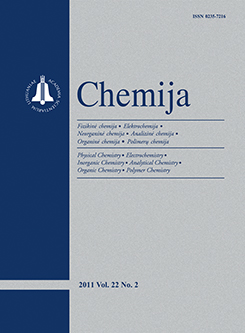Chemija / Chemistry
 ISSN 0235-7216 ISSN 2424-4538 (online) |
2017 m. Nr. 4 Modification of polyamide films by semiconductive and conductive copper selenide–copper sulfide layers
Modification of the surface of polyamide 6 (PA) films by semiconductive and electrically conductive layers of mixed copper selenide–copper sulfide, CuxSe–CuyS, was performed using the sorption–diffusion method and the water solutions of potassium selenopentathionate, K2SeS4O6, as the precursor of polymer chalcogeniumization. Selenopentathionate anions containing divalent selenium and sulfur atoms of low oxidation state,–O3S-S-Se-S-SO3 –, are sorbed-diffused into PA films if they are treated with selenopentathionate solutions. CuxSe–CuyS layers form on the surface of a PA (polyamide 6) film when a chalcogeniumized polymer is treated with a water solution of copper(II/I) salt: the anions of selenopentathionate react with copper ions. The concentration of sulfur, selenium and copper increases with an increase of the concentration and temperature of a precursor solution and the duration of PA initial chalcogeniumization. The formed layers were characterized for chemical composition, electrical and physical properties. The percentage amounts of selenium, sulfur and copper in CuxSe–CuyS layers on PA films increase with polymer chalcogeniumization time. The X–ray diffraction (XRD) pattern study of CuxSe–CuyS layers showed that they are polycrystalline in nature. The six phases of copper selenides – Cu2Se, CuSe2, CuSe2, Cu3Se2, berzellianite Cu2-xSe and bellidoite Cu2Se, also the four phases of copper sulfides – monoclinic djurleite, Cu1.9375Se, cubic digenite, Cu1.8S, orthorhombic chalcocite, Cu2S, and orthohrombic anilite, Cu1.75S, have been identified. With an increase of the concentration and temperature of the precursor solution and the duration of PA treatment the highest concentration of conductive copper selenides is reached and the composition of CuxSe phases changes in the direction of a decrease of x. XPS results confirmed the formation of copper selenides–copper sulfides layers on the surface of PA. The regularities established enable formation of CuxSe–CuyS layers of the desirable composition and conductivity. Studies by the method of atomic force microscopy (AFM) showed that depending on the conditions (duration of chalcogeniumization, concentration and temperature) of the PA initial treatment in the K2SeS4O6 solution (under the same “copperizing” conditions), the formation of copper chalcogenide layers proceeds irregularly in the form of islands which grow into larger agglomerates. The surface of the layer is uneven, rather rough.
Keywords: polyamide, copper selenide–copper sulfide layer, scanning electron microscopy, X-ray diffraction, X-ray photoelectron spectroscopy, atomic force microscopy |
Issues:
2017 - Vol.28 No. 1, No. 2, No. 3, No. 4 2016 - Vol.27 No. 1, No. 2, No. 3, No. 4 2015 - Vol.26 No. 1, No. 2, No. 3, No. 4 2014 - Vol.25 No. 1, No. 2, No. 3, No. 4 2013 - Vol.24 No. 1, No. 2, No. 3, No. 4 2012 - Vol.23 No. 1, No. 2, No. 3, No. 4 2011 - Vol.22 No. 1, No. 2, No. 3, No. 4 2010 - Vol.21 No. 1, No. 2-4 2009 - Vol.20 No. 1, No. 2, No. 3, No. 4 2008 - Vol.19 No. 1, No. 2, No. 3-4 2007 - Vol.18 No. 1, No. 2, No. 3, No. 4 2006 - Vol.17 No. 1, No. 2-3, No. 4 2005 - Vol.16 No. 1, No. 2, No. 3-4 2004 - Vol.15 No. 1, No. 2, No. 3, No. 4 2003 - Vol.14 No. 1, No. 2, No. 3, No. 4 2002 - Vol.13 No. 1, No. 2, No. 3, No. 4 2001 - Vol.12 No. 1, No. 2, No. 3, No. 4 |